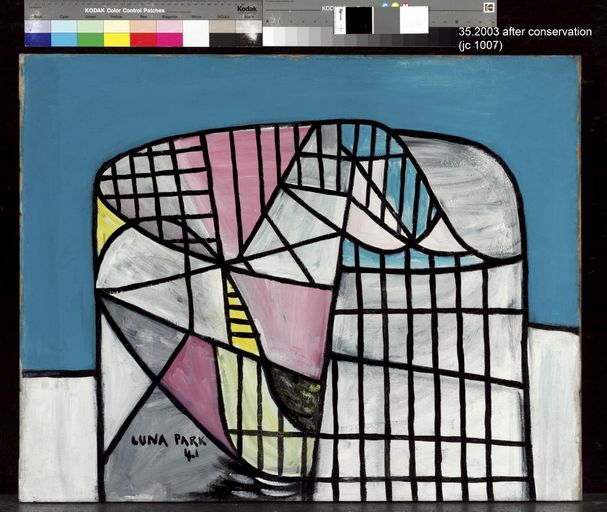

Luna Park, 1941
Sidney Nolan, Luna Park, 1941, 67.0 x 84.0 cm, nitrocellulose lacquer on canvas, © The Trustees of the Sidney Nolan Trust
Dr Paula Dredge is Teaching Specialist at The Grimwade Centre for Cultural Materials Conservation and previously the Head of Paintings Conservation at the Art Gallery of New South Wales. Her PhD thesis was an analytical and historical study of the household paints used by Sidney Nolan from 1939 to 1953.
"While preparing paintings for the Sidney Nolan retrospective exhibition in 2008, I was cataloguing a collection of paints from Nolan’s studio in Wahroonga, Sydney, given to the Art Gallery of NSW by his daughter Jinx Nolan. No traditional artist’s oil paints among them, they were a time capsule of household paint technology from the mid 20th century and included many paint trade names which were entirely unknown in their content; Ripolin, Dulux, Kemtone and Surtint. When I was asked by the exhibition curators what Nolan’s paintings might be made from, I was filled with uncertainty. Luna Park for example had previously been catalogued as enamel and as oil, but was it the glossy Ripolin paint he had been so well known for using? Or could it be Dulux or even artist’s oil paint? After scientific analysis of the paints from the Wahroonga studio and then the works themselves, the paint medium of Luna Park was revealed as something else entirely; nitrocellulose lacquer.
The most popular brand of nitrocellulose paint, Duco, had been developed in the 1920s as a paint for motor cars and then signage and even for recolouring leather shoes during the depression of the 1930s. This would have been a paint type familiar to Nolan from his work making signs for cars in a factory at the age of 13 and displays for the Fayrefield Hat company in Melbourne through the 1930s. Usually applied with spray guns, nitrocellulose paints dried quickly and were difficult to work with a brush.
How Nolan could have painted Luna Park using such a fast-drying paint is still mysterious, but the need to paint fast and have his paint dry faster appears to have been a quest he pursued throughout his life. Nolan moved on from nitrocellulose to work with other household paints such as Dulux in 1942, (the first synthetic paint made from polyester), Ripolin in 1943, (oils cooked with driers) then mixing his own paints from ‘white glue’, PVA, in the 1950s and alkyd gel medium in the 1960s.
Now, as I work through the hundreds of items left in his studio at his house in the U.K., The Rodd, it is the commitment to any type of paint or additive which sped drying and required new technical challenges in application, that appears to have inspired Nolan. Perhaps it is no surprise that he took to paint in spray cans in 1981 before they became the well-known medium of street artists. The spray cans dominate his last studio, set out on tables for access to a range of colours like a traditional artist’s palette. No doubt he took to the spray as a technique harking back to his first jobs, but now wielded two-handed like a double set of guns firing at the canvas. The spray cans produced spectacular effects of coloured sky and water, likenesses in portraits and huge abstracts with intense colours and powdery matt surfaces; paint effects controlled only by the distance and position of the cans in steady hands."